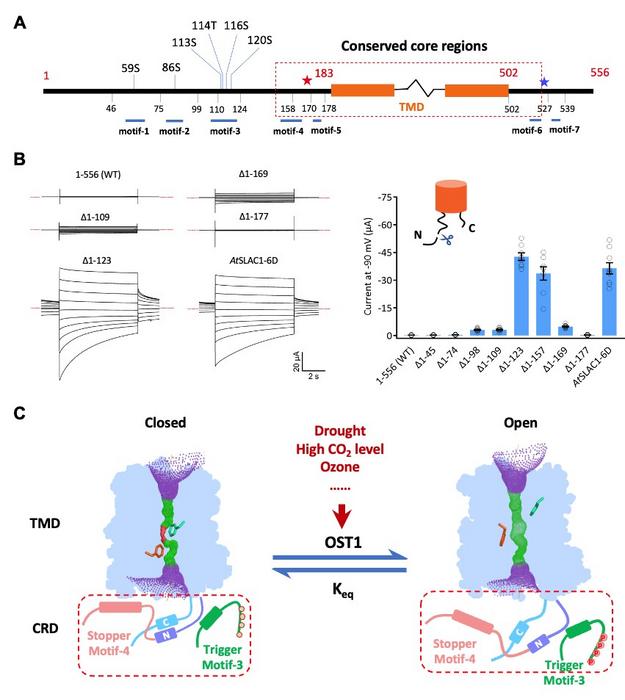In a study published in PNAS on July 8, researchers from the Institute of Genetics and Developmental Biology (IGDB) of the Chinese Academy of Sciences (CAS) have provided mechanistic insights into how SLAC1, a key anion channel specifically expressed on the plasma membrane of guard cells that form stomata in plant leaves, is activated by phosphorylation.

Credit: IGDB
In a study published in PNAS on July 8, researchers from the Institute of Genetics and Developmental Biology (IGDB) of the Chinese Academy of Sciences (CAS) have provided mechanistic insights into how SLAC1, a key anion channel specifically expressed on the plasma membrane of guard cells that form stomata in plant leaves, is activated by phosphorylation.
Plants adjust their stomatal pores in response to environmental cues such as high levels of carbon dioxide, ozone, drought, and microbial invasion to adapt to environmental changes and support growth, according to the researchers.
Plants sense environmental signals and control the phosphorylation of SLAC1 through protein kinases. When activated, SLAC1 facilitates anion efflux from the guard cells, causing membrane depolarization that activates downstream GORK channels, thereby reducing turgor pressure and closing the stomata.
Previously, the researchers unveiled the first cryo-EM structure of plant SLAC1, which mainly includes the transmembrane domain (TMD) but lacks its N- and C-terminal “tails” (~180 aa and ~60 aa, respectively) due to their flexibility. They also identified six critical phosphorylation sites on the N-terminus that are essential for channel activation; however, the mechanism underlying phosphoctivation remains elusive.
In this study, they showed that SLAC1 channels are maintained in an auto-inhibited state by their N-termini, which, when removed, lead to kinase-independent activation. AlphaFold modeling showed that the flexible N- and C-termini form a cytosolic regulatory domain (CRD) that interacts with the pore-forming TMD to maintain the auto-inhibited state. In response to environmental cues, plants phosphorylate SLAC1, releasing it from auto-inhibition and allowing activation.
Further studies reveal that this activation induces a conformational change in the CRD, reorienting the pore helices within the TMD, thus causing anion efflux and membrane depolarization, ultimately leading to stomatal closure.
Precise control of these pores is crucial because inadequate opening can impede photosynthesis, while excessive opening can lead to plant dehydration and wilting.
These findings help scientists understand how plants cope with extreme and varying environmental climate changes, such as drought and increased carbon dioxide and ozone levels. A deeper understanding of the mechanism of SLAC1 in stomatal control will be crucial for developing drought-resistant or water-efficient plant cultivation strategies.
This work was funded by the National Key R&D Program of China, the National Natural Science Foundation of China, and the Strategic Priority Research Program of CAS, etc.
Journal
Proceedings of the National Academy of Sciences
DOI
10.1073/pnas.2323040121
Method of Research
Experimental study
Subject of Research
Not applicable
Article Title
Mechanistic insights into phosphoactivation of SLAC1 in guard cell signaling
Article Publication Date
10-Jul-2024




